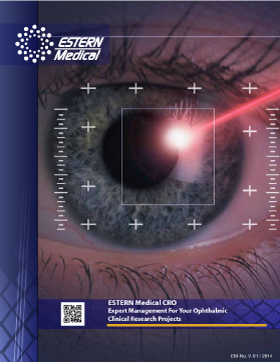Ophtalmology
Clinical Research Trial Projects
ESTERN Medical has been the CRO of choice for ophthalmic device (implantable, surgical and diagnostic), and pharmaceutical clinical research projects for clients ranging from industry leaders to early-stage and global
companies across Latin America.
The projects that we have managed range from single site Phase I and II studies involving less than 100 subjects followed for one week to large Phase III multi-center projects involving several hundred subjects.
Our project objectives also vary from assessing the feasibility of clinical development programs to performing the pivotal study of safety and effectiveness in support of a pre-market FDA & EMEA approval submission to providing data that can be used to support corporate marketing objectives.
Efficient Management For Ophthalmic Research Projects
We maintain an extensive network of research ophthalmologists and KOLS in Latin America who are specialists in cornea, retina, glaucoma and ophthalmology diseases. These resources provide expert guidance and advice on ophthalmic clinical program development.
Our network of study sites, located throughout Latin America in Mexico, Colombia, Peru, Chile and Argentina in hospitals, clinics and private practice-based and Hospitals can provide early phase through pivotal/Phase II & III and post-market studies.
Our involvement typically includes overall project regulatory management, clinical site management monitoring and medical writing support for surgical and medical therapies associated with:
- Age-related macular degeneration
- Cataract, including removal and intraocular lens replacement
- Diabetic retinopathy
- Dry eye
- Glaucoma
- Intravitreal hemorrhage
- Macular edema
- Ophthalmic wound healing
- Proliferative retinopathy
- Refractive disorders, including myopia, hyperopia and presbyopia
- Seasonal allergic conjunctivitis
Procedural Familiarity And Program Efficiencies
At ESTERN Medical CRO, we understand that ophthalmic study design and implementation requirements may be quite different from studies in other medical specialties.
Our staff is familiar with the terminology, exams and instrumentation used in ophthalmology practices, and, just as important, we are aware of the details associated with ophthalmic patient recruitment and follow-up.
Our systems include plans, procedures and templates that can be readily customized for ophthalmic clinical trials projects. These assets allow us to rapidly develop comprehensive project plans and quickly assemble skilled, highly-rated project teams to partner with our clients for optimal success. And because of our depth of experience, trials tend to have better patient recruitment results and to run on-time and within budget.
Our Ophthalmic Clinical Program Capabilities Include
- Regulatory strategy consultation: Helping clients understand and manage regulatory procedures and requirements to facilitate achievement of product approval objectives
- Ophthalmic therapy-specific clinical consultation: supplying specialty-specific expertise to facilitate the development or implementation of study protocols
- Study feasibility assessments (Latin America): Understanding the issues that may affect study performance (appropriate study sites, patient recruitment)
- Regulatory submissions (Latin America): IDE, IND, 510(k), PMA, NDA, country-specific-product approval dossiers
- Early phase/safety studies (Latin America)
- Product registration studies (Latin America)
ESTERN Medical CRO Ophthalmology Clinical Project Experience
Pharmaceutical Products:
- Ph II study to evaluate safety and tolerability of an intravitreal implant for treatment of DME (Diabetic Macular Edema)
- Ph II trial to assess safety and efficacy of a posterior segment drug delivery system for treatment of persistent macular edema
- Ph II safety and efficacy assessment of an intravitreal injection to prevent recurrence of PVR (Proliferative Vitreoretinopathy)
- Ph II investigation of an injectable solution for acceleration of clearance of intra-vitreal hemorrhage
- Ph II study of ocular tolerance of eye drops in patients with bilateral mild to moderate dry eye syndrome
- Ph IIIB multi-center study to compare efficacy and safety of an ophthalmic emulsion vs. a masked artificial tear in patients with moderate to severe KCS (Keratoconjunctivitis Sicca)
- Ph IV studies of proprietary eye drops in the treatment of SAC
- Ph IV study of restoration of corneal sensitivity and surface integrity in dry eye with a topical ophthalmic solution
- Ph IV trial of the safety and efficacy of an ophthalmic solution for treatment of posterior lid margin blepharitis with or without rosacea or KCS (Keratoconjunctivitis Sicca)
Ophthalmology Clinical Project Experience
Medical devices:
- A clinical comparison of an Er:Yag laser to phacoemulsification for extraction of cataract
- A multi-center, open-label, 1-week study to evaluate the consumer acceptance of two prototypes of a new dispenser in patients with glaucoma
- Prospective, multi-center studies to evaluate the safety and effectiveness of foldable intraocular lenses in patients undergoing cataract extraction.
- Clinical investigation of a collagen glaucoma drainage device.
- Clinical investigations of pediatric, low myopia and anterior chamber IOLs (intraocular lens)
- Evaluations of currently marketed refractive lasers to assess differences in contrast sensitivity
- Results of surgical removal of malignant eyelid tumors with frozen section controlled excision
- Studies of use of refractive data from a wavefront measurement device for correction of PRK and LASIK refractive error.
- Studies of an implantable contact lens for treatment of myopia and hyperopia (product registration)
- Studies of laser thermal keratoplasty for correction of hyperopia.
- Study of a retinal tamponnade product
- A trial of scleral expansion bands for treatment of presbyopia.
- Evaluations of a phacoemulsification system software upgrade to assess impact on corneal clarity and surgeon technique




